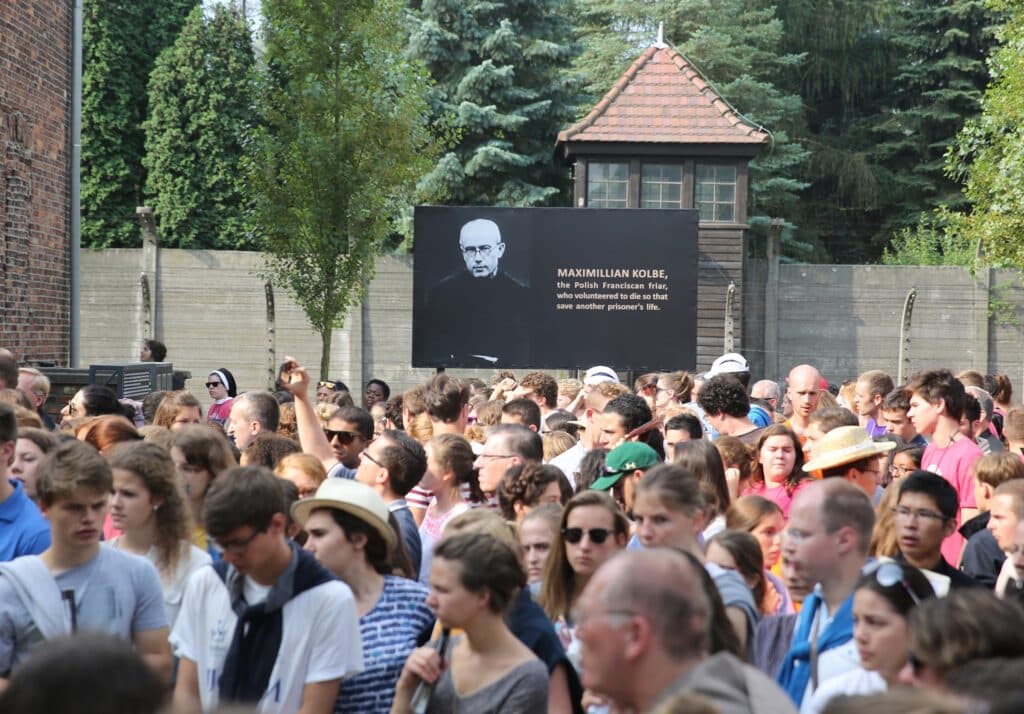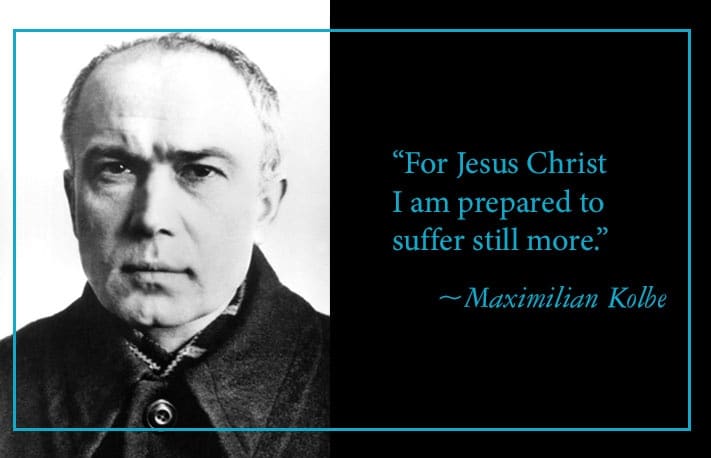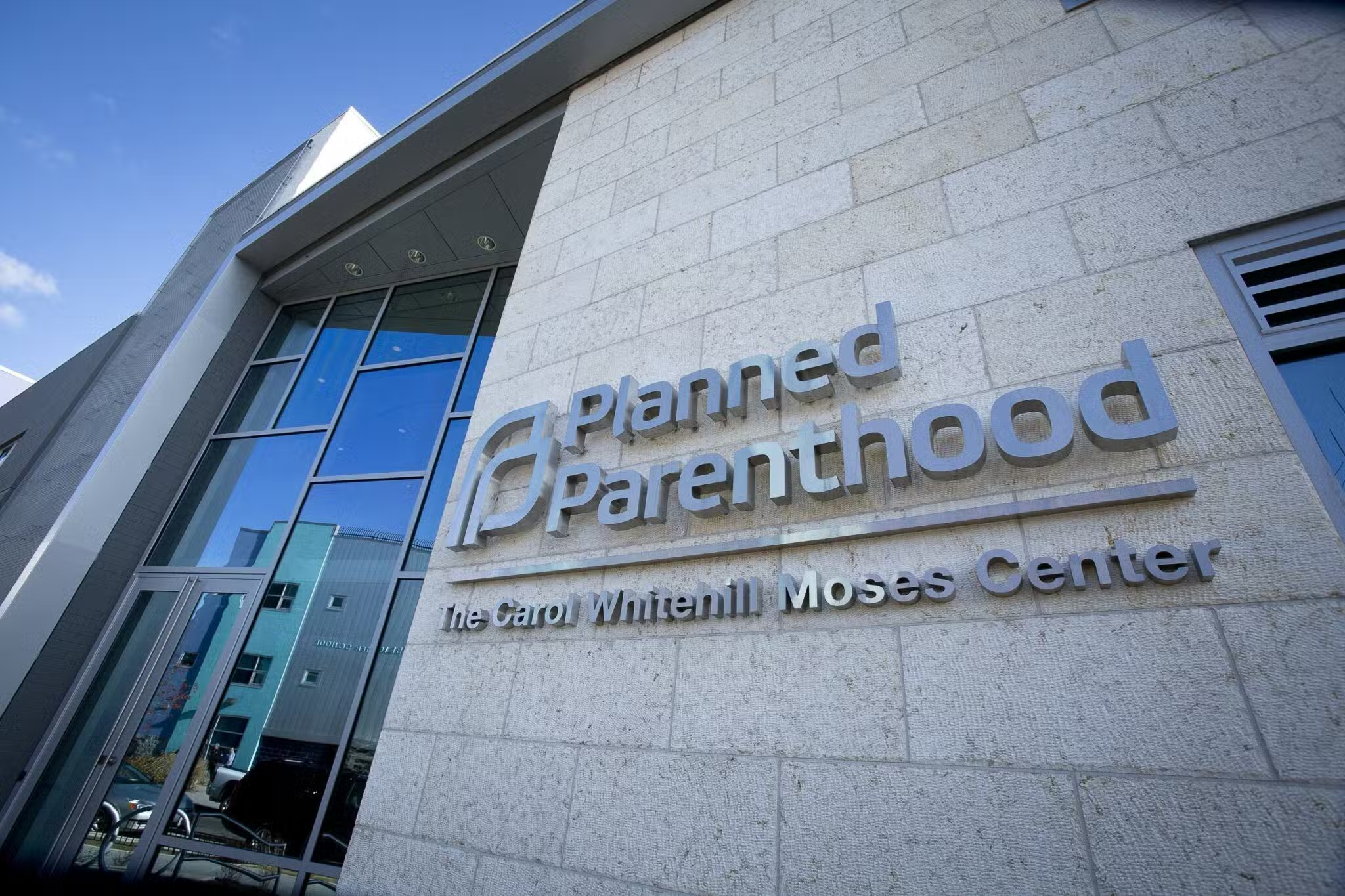St. Maximilian Kolbe is known as a martyr of the Holocaust. The Conventual Franciscan friar was executed on August 14, 1941, at Auschwitz, after giving up his life for another inmate.
His body, like those of most people who died at Auschwitz, was cremated, and the ashes were dumped in a marshy area outside the camp. That would seem to make it difficult to find first-class relics of the saint. First-class relics, defined as bodily remains of a saint, can be as large as bones or even the entire skeleton, or as small as a drop of blood or fragment of hair.
So when Chicago’s St. Ita Parish, a multi-ethnic community led by the Conventual Franciscans, announced that it had received a first-class relic of St. Maximilian in January 2018, the first question people asked the pastor was how such a thing even existed. The second, according to Conventual Franciscan Father Robert Cook, was how the parish ended up with it.
The answers to both questions lie in a web of relationships that binds St. Maximilian and Niepokalanow, a monastery he founded in Poland in 1927, with the Conventual Franciscans in the United States and St. Ita Parish.
At the center is the friendship between Conventual Franciscan Friar James McCurry and Franciszek Gajowniczek, the man whose place St. Maximilian took when he volunteered to be executed in August 1941. Father McCurry is provincial of the order’s Our Lady of the Angels Province, which covers the eastern part of the United States.
A Barber and a Pickle Jar
Father McCurry shared the story on the evening that St. Maximilian’s relic was installed at St. Ita. The congregation included friars from Marytown, home of the National Shrine of St. Maximilian Kolbe in the Chicago suburb of Libertyville, as well as dozens of St. Ita parishioners, many of whom hail from countries in Africa and Asia.
It was at Niepokalanow that the fragments of hair—actually trimmings from St. Maximilian’s beard—have been preserved since 1939, Father McCurry says. That the beard trimmings exist at all is something of a miracle, and it is based on the foresight of the barber at Niepokalanow. Maximilian wanted his long beard shaved off to make it harder for the Nazis to recognize him. The barber thought he might have a future saint sitting in his chair, so he tried to tuck the clippings away.
Maximilian noticed, and directed him to put the hair in the stove so it could be burned. The barber did, knowing full well that the day was warm and the stove was cold, Father McCurry says. When Maximilian left the room, the barber retrieved the clippings and hid them in a pickle jar, where they remained safe.
The existence of the relics is not a secret—the friars brought them on an eight-month tour of the United States in 2016—and the Niepokalanow website offers information on how parishes can request a relic. Fragments of clippings from the saint’s beard have been shared with churches around the world since St. Maximilian was canonized by Pope John Paul II on October 10, 1982.
According to the guidelines, the community at Niepokalanow provides relics only to parishes that will make them available for public veneration, have a letter from the local bishop in support of the request, and can send someone to present the documentation and receive the relic in person.
All of that came together for St. Ita in 2017, when a member of the parish’s Polish community was able to visit Niepokalanow on the feast of the Immaculate Conception and carry the relic back to Chicago. That parishioner wishes to remain anonymous.
Those kinds of connections are just what relics are meant to reinforce, says Father Cook, who has met several friars who knew St. Maximilian. Father Cook likes to compare Catholic veneration of relics to the way he keeps mementos of his mother, who, while not canonized, is surely in heaven, he says. Spending time with things that were important to her makes him feel close to her, he adds.
The relic of St. Maximilian, housed in a reliquary adorned with a tau cross (p. 41), is one of several displayed at St. Ita. The same parishioner who collected the St. Maximilian relic brought two others from Poland on other trips: one from St. Faustina Kowalska and another from St. John Paul II.
“We Catholics do not worship relics,” Father McCurry said at the installation. “We honor them and pay respect to them.” In doing so, Catholics are living in the community of saints and demonstrating their belief that the living and the dead are connected throughout eternity, he said.
Laying Down His Life for Another
Father McCurry told the congregation that St. Maximilian volunteered to take the place of Gajowniczek as one of 10 men to be put to death as punishment for another prisoner who had escaped. When he was selected, Gajowniczek cried out, asking what would happen to his wife and child if he were killed.
St. Maximilian stepped forward, identified himself as a Catholic priest, and volunteered to take his place. At the time, most of the inmates at Auschwitz were Polish Catholics. It was the year before the Nazis launched the “Final Solution, ” their attempt to exterminate the Jews of Europe.
Even so, the camp commandant welcomed inmates by telling them the only way out of the work camp was through the crematorium, Father McCurry says. Men would be worked to death, however long that took. Certain groups were targeted for death sooner: Jews had two weeks, the commandant said, and Catholic priests had a month. His offer was accepted, and St. Maximilian (prisoner 16670) and the other nine men were stripped of their clothes and locked in a dark underground bunker without food or water.
Gajowniczek, who died in 1995, and other camp inmates who survived the war said that instead of screaming, they heard hymns to Mary and rosary prayers from the bunker, at least at first. Later, it was silent.
“The grace of God, the peace of Christ, was triumphing over the hatred of the Nazis,” Father McCurry says. “[St. Maximilian] accompanied nine hungry, thirsty, naked, homeless, sick, imprisoned people into the death cell and ministered to them.”
When the bunker was opened two weeks later, Kolbe was the only one of the 10 left alive. He was executed with an intravenous injection of carbolic acid, an excruciating way to die. After the war, Gajowniczek and others who knew St. Maximilian said that he often found ways to minister to the other prisoners and inspire them to hope.
“It’s clear that Maximilian had a plan from the moment he walked through those gates,” Father McCurry says. “He was determined to counteract the evil of the Nazi guards by the charity he exhibited.” That meant he gave away some of the meager morsels of food he received, prayed, and heard confessions. He is believed to have saved the life of a 14-year-old Jewish boy who was assigned to his barracks with 600 other men and was in despair because he had been separated from his family. St. Maximilian encouraged him and helped him blend in.
“He said, ‘Hatred destroys. Only love creates,'” Father McCurry says. It was a message Gajowniczek took to heart, and he often spoke about St. Maximilian. He was a guest at the Vatican for St. Maximilian’s beatification in 1971 and at his canonization in 1982. He traveled frequently to the United States to tell his story, and, for many years, his designated driver and escort was Father McCurry.
A Saint and a Brother
Father McCurry says his connection to St. Maximilian was formed decades ago when he was a young friar. Shortly after St. Maximilian Kolbe was beatified, Father McCurry taught at Kolbe High School in Bridgeport, Connecticut, and a portrait of then-Blessed Maximilian hung in his classroom.
“I used to ask him for help,” Father McCurry recalls. “As a Franciscan friar, I look at him as a brother. He’s more than a saint to me. The beauty of our Church is that the saints in heaven and we on earth are bonded. We are bonded in prayer and in love. Saints like Maximilian Kolbe are not distant figures from the past. They are living.”
Father McCurry led a pilgrimage of 750 American Catholics to Rome for Kolbe’s canonization Mass in 1982 and managed to get a sneak peek at the vestments Pope John Paul II would wear the day before the rite. They were red, confirming that John Paul would canonize him as a martyr.
That had been in question, Father McCurry says, since St. Maximilian was killed not for his faith, but in laying down his life to spare another. “To be a martyr, you had to die rather than deny the faith, ” Father McCurry explained. “St. Maximilian Kolbe died putting the faith into the practice of heroic charity.”

Sneaking back out of the vesting room, Father McCurry bumped into Mother Teresa, who spoke to him of the “heroic example of charity” St. Maximilian offered. “She said he showed how the Blessed Mother enables us to live lives of heroic charity,” he says.
Father McCurry also brought up the gifts at the Mass and had a brief encounter with Pope John Paul II. When he offered his gift, he asked the pope, “Holy Father, please pray that all of us can be as consecrated to Our Lady as Maximilian Kolbe was.”
“He pointed right at me and said, ‘You do that,'” Father McCurry said in his homily at St. Ita, just before the whole parish consecrated itself to Mary. They did so, says Father Cook, “because that is what St. Maximilian would have wanted.” Father McCurry says the message of St. Maximilian Kolbe is just as relevant now as it ever was, and that message includes not simply his death but also his life.
Devoted to Our Lady
St. Maximilian, already a prominent Catholic leader in 1939 when the Nazis invaded Poland, knew he would likely be targeted, according to Father McCurry.
As a boy of about 10 years of age, he had a vision of Mary in his hometown parish, St. Matthew Church. She offered him two crowns: red for martyrdom and white for lifelong purity. She asked which he would choose; he asked for both, and she gave them to him.
“The key to him being able to lead that kind of a life was Our Lady, who had invited him,” Father McCurry says. “It wasn’t a lot of pious claptrap. It was so meaningful that it gave him hope and purpose.”
When he was 13, he and his brother illegally crossed the border into Austria-Hungary to enter the Conventual Franciscan seminary. In 1910, he was given the religious name Maximilian, and he made his final vows as a friar in 1914. He studied for the priesthood in Rome, and, while he was there, he founded the Militia of the Immaculata, the worldwide evangelization movement that encourages consecration to the Blessed Virgin Mary.
Five years later, after being ordained, he started the Knights of the Immaculata magazine in Poland, and five years after that, St. Maximilian founded Niepokalanow. The community used print media and radio to spread the word that people should love Mary as a mother if they wanted to get closer to Jesus. Despite poor health, St. Maximilian expanded his evangelization efforts to Japan in 1930.
When his health forced him to return to Poland in 1938, Niepokalanow was home to more than 600 friars, and Knights of the Immaculata had the largest circulation of any religious publication in Poland. That was enough to draw the interest of the Nazis, who invaded the country on September 1, 1939. As he expected, he was arrested on September 13, 1939, on “general suspicion” and was released after a brief time.
Meanwhile, the friars at Niepokalanow had begun offering shelter to Poles fleeing the Nazis, Catholics and Jews alike. Kolbe himself penned one last essay, entitled “Pravda,” or “Truth,” explaining how the Nazis “were out to destroy the whole Judeo-Christian way of life,” Father McCurry says.
In February 1941, he was arrested again. This time, he was sent to Auschwitz. St. Maximilian’s example offers a path for anyone living in despair, Father McCurry says.
“Many people have any number of causes for getting discouraged,” he says. “To anyone, Maximilian Kolbe would give the same advice: Go to Mary. Let her minister to you. She knows your troubles.”








